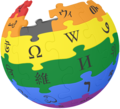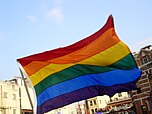| Main page | WikiProjects & Things you can do |

|
The LGBTQ+ Portal |

|

|

|
Introduction LGBT is an initialism that stands for "lesbian, gay, bisexual, and transgender". It may refer to anyone who is non-heterosexual, non-heteroromantic, or non-cisgender, instead of exclusively to people who are lesbian, gay, bisexual, or transgender. A variant, LGBTQ, adds the letter Q for those who identify as queer (which can be synonymous with LGBT) or are questioning their sexual or gender identity. Another variation, LGBTQ+, adds a plus sign "represents those who are part of the community, but for whom LGBTQ does not accurately capture or reflect their identity". Many further variations of the acronym exist, such as LGBT+ (simplified to encompass the Q concept within the plus sign), LGBTQIA+ (adding intersex, asexual, aromantic and agender), and 2SLGBTQ+ (adding two-spirit for a term specific to Indigenous North Americans). The LGBT label is not universally agreed to by everyone that it is generally intended to include. The variations GLBT and GLBTQ rearrange the letters in the acronym. In use since the late 1980s, the initialism, as well as some of its common variants, functions as an umbrella term for marginalized sexualities and gender identities. LGBT is an adaptation of LGB, which in the mid-to-late 1980s began to replace the term gay (or gay and lesbian) in reference to the broader LGBT community. When not inclusive of transgender people, the shorter LGB is still used. (Full article...) Selected article -Homosexuality is a sexual attraction, romantic attraction, or sexual behavior between members of the same sex or gender. As a sexual orientation, homosexuality is "an enduring pattern of emotional, romantic, and/or sexual attractions" exclusively to people of the same sex or gender. It "also refers to a person's sense of identity based on those attractions, related behaviors, and membership in a community of others who share those attractions." Along with bisexuality and heterosexuality, homosexuality is one of the three main categories of sexual orientation within the heterosexual–homosexual continuum. Scientists do not yet know the exact cause of sexual orientation, but they theorize that it is caused by a complex interplay of genetic, hormonal, and environmental influences and do not view it as a choice. Although no single theory on the cause of sexual orientation has yet gained widespread support, scientists favor biologically based theories. There is considerably more evidence supporting nonsocial, biological causes of sexual orientation than social ones, especially for males. There is no substantive evidence which suggests parenting or early childhood experiences play a role with regard to sexual orientation. While some believe that homosexual activity is unnatural, scientific research shows that homosexuality is a normal and natural variation in human sexuality and is not in and of itself a source of negative psychological effects. There is insufficient evidence to support the use of psychological interventions to change sexual orientation. (Full article...)Selected biography -Matthew Richard Lucas (born 5 March 1974) is an English actor, comedian, writer, and television presenter. He is best known for his work with David Walliams on the BBC sketch comedy series Little Britain (2003–2006) and Come Fly with Me (2010–2011). Lucas first came to prominence on the comedy panel show Shooting Stars, in which he portrayed scorekeeper George Dawes from 1995 to 2009. From 2015 to 2017, he portrayed the role of Nardole in the BBC series Doctor Who. He has also appeared in films, including Astro Boy (2009), Alice in Wonderland (2010), Bridesmaids, Gnomeo & Juliet (both 2011), Small Apartments (2012), Paddington (2014), and Wonka (2023). Lucas presented the baking competition show The Great British Bake Off, alongside Noel Fielding from 2020 to 2023. (Full article...)Selected quote -
Current events
Selected image - Boy with a Basket of Fruit (1593–94) is a painting by Caravaggio. The model was his friend and lover, the Sicilian painter Mario Minniti, about 16 years old at the time. At one level the painting is designed to demonstrate the artist's ability to depict everything realistically, from the boy's skin to the folds of the robe to the weave of the basket. A closer look however reveals that, as in another painting by him from that time (Basket of Fruit), the peaches have spots and the leaves are diseased, perhaps a comment by the artist on the closeness of beauty and decay in life.
Did you know… -
This month's birthdays
Selected lists
Related portalsFeatured contentThe following articles and lists have been identified as some of the best produced by the Wikipedia community:
TopicsCategoriesAssociated WikimediaThe following Wikimedia Foundation sister projects provide more on this subject:
Discover Wikipedia using portals |
Purge server cache
























